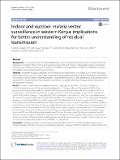| dc.contributor.author | Teshome Degefa, Delenasaw Yewhalaw, Guofa Zhou, Ming-chieh Lee, Harrysone Atieli, Andrew K. Githeko & Guiyun Yan | |
| dc.date.accessioned | 2022-01-29T08:50:41Z | |
| dc.date.available | 2022-01-29T08:50:41Z | |
| dc.date.issued | 2017 | |
| dc.identifier.uri | https://repository.maseno.ac.ke/handle/123456789/4749 | |
| dc.description | DOI 10.1186/s12936-017-2098-z
Malaria Journal | en_US |
| dc.description.abstract | The widespread use of indoor-based malaria vector control interventions has been shown to alter the behaviour of vectors in Africa. There is an increasing concern that such changes could sustain residual transmission. This study was conducted to assess vector species composition, feeding behaviour and their contribution to indoor and outdoor malaria transmission in western Kenya. | en_US |
| dc.publisher | Springer | en_US |
| dc.subject | Malaria vectors, Surveillance, Behavior, Residual transmission, Kenya | en_US |
| dc.title | Indoor and outdoor malaria vector surveillance in western Kenya: implications for better understanding of residual transmission | en_US |
| dc.type | Article | en_US |

